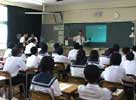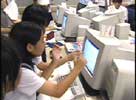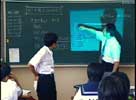
| Place |
 |
■Regular
classroom □Computer room ■Special classroom □Gymnasium
□Athletic Field □Outdoors □Others〔 〕 |
 |
 |
 |
| Type
of Lesson |
 |
■Class □Group □Pair/Individual □Follow-up □Others〔 〕 |
 |
 |
 |
| Phase |
 |
■Introduction □Development □Conclusion □Others〔 〕 |
 |
 |
 |
| Main
user of IT |
 |
■Teacher ■Student □Others〔 〕 |
 |
 |
 |
| Objectives |
 |
■To
introduce the topic □To motivate students □As illustrative material
used by the teacher □As illustrative material used by the student □To
master through repetition □To present a model □To recollect past experiences □To
compare □To examine what has been done/studied □To provide second-hand
experience ■Others〔Approach to problem solving〕 |
 |
 |
 |
| Equipment |
 |
■Computer ■Projector □Screen □Electronic
Whiteboard □Visual Presenter □Digital Camera □Video Player □Internet □Digital
Contents □CD-ROM □Speakers □Others〔 〕 |
|


| It is an excellent example of how
a math class can be made more fun easily and effectively by the use of
a computer. |


Discover Mathematical
Functions in Shapes and Figures
Contents: based on MEXT's curriculum
guidelines
| (2) |
Project-based studies should be properly positioned and
implemented into the lesson plans of each grade so that students
can actively participate in class and develop a mathematical approach.
For these studies, appropriate tasks are chosen to combine contents from various fields and to relate them to daily phenomena, where students' study work, observation,
experiment and research activities are emphasized,
should be properly positioned and implemented into the lesson plans of each
grade. |


Use the computer effectively to
collect information about mathematical functions found in shapes and figures


| (1) |
Present
the math problem. |
|
|
Use the projector to illustrate
the problem on the blackboard. |
|
|
|
|
|
[Problem]
Rectangle ABCD has a height of 10 cm. and width of 20 cm. Point P moves
between points A and B while Point Q moves twice as fast as P between
points B and C. When P moves, other factors also change and we have
lost track of what the numbers shown on the lower left of the screen
denote. Find out what each number represents. |
|
| (2) |
Individual inquiry. |
|
|
Solve the problem using
the computer.
Determine the numbers as each student sees fit. |
|
| (3) |
Group inquiry. |
|
|
Share the possible solution
with the other group members.
Have a discussion toward matching the numbers to the sides of the rectangle. |
|


This can also be used as introductory
material for math functions. It can also be used to study and find numbers
that interact.


|



